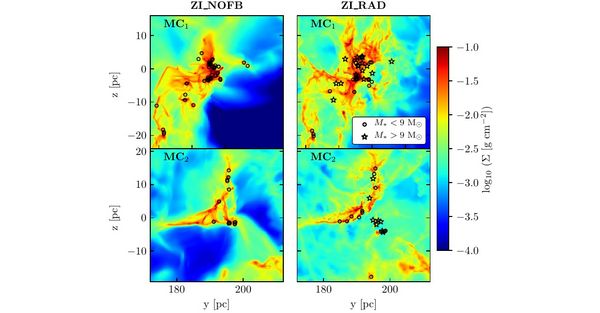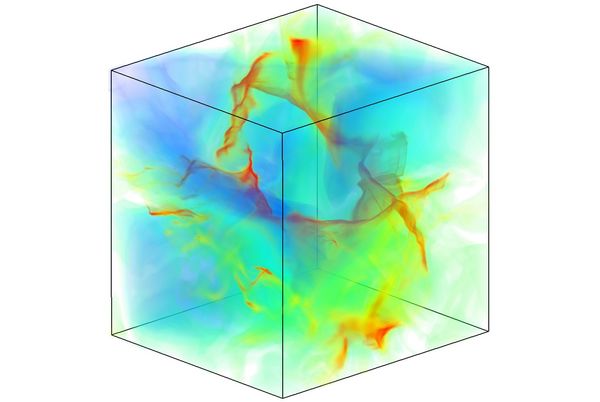ASTROPHYSICS
Simulating the Formation, Evolution, and Merging of Molecular Clouds
Principal Investigator:
Daniel Seifried
Affiliation:
I. Physikalisches Institut, Universität zu Köln
Local Project ID:
pr94du
HPC Platform used:
SuperMUC and SuperMUC-NG of LRZ
Date published:
Introduction
In our research we investigate the formation and evolution of molecular clouds by means of highresolution zoom-in simulations of stratified galactic disks. The simulations are a follow-up of the work performed in the Large-Scale Gauss Project pr62su carried out on the general purpose supercomputer SuperMUC, where the long-term evolution of different galactic disks was modeled with significantly lower spatial resolution [1,2]. By zooming in with a smart adaptive mesh refinement technique, we center on individual molecular clouds while these are forming and evolving within a realistic environment. We thus can explore the impact of e.g. supernova explosions or stellar radiation on the clouds. In particular we are interested in the chemical evolution of the clouds as well as the internal dynamics and structure.
Results and Methods
In our work we have so far performed a number of simulations on SuperMUC Phase 2 and SuperMUC-NG. Each of the simulations required a computational time of a about 1-2 Mio. core hours with a simultaneous use of up to 1,000 cores per simulation. A few hundreds of files were produce for each simulation requiring a disk space of about 20 TB in total. The simulations are performed with the hydrodynamics code FLASH [3], written in Fortran 90. The code solves the 3-dimensional, discretized magneto-hydrodynamical equations on a Cartesian grid. Making use of the adaptive-mesh-refinement (AMR) technique, only those regions which are of particular interest for us are resolved with the highest possible spatial resolution whereas other regions of minor interest are resolved more coarsely. This significantly reduces the number of calculations to be performed and hence the computational time required, thus allowing us to perform the simulations over long physical timescales. Furthermore, we use a chemical network designed for astrophysical problems which allows us to model the formation of molecular hydrogen and CO, and non-equilibrium cooling and heating effects.
Initial conditions
The simulations we carry out follow the evolution of the multi-phase ISM in a (500 pc) × (500 pc) × (± 5 kpc) region of a galactic disk, with a gas surface density of 10 Msun/pc2. We include an external potential, self-gravity, magnetic fields, heating and radiative cooling, as well as time-dependent chemistry. We explore SN explosions at different rates in located either in high-density regions, in random locations, in a combination of both, or clustered in space and time. We select regions from these runs where we know that molecular clouds are forming and then start to zoom-in [4]. This allows us to follow the evolution of molecular clouds with a significantly higher spatial resolution of 0.06 pc.
The structure of molecular clouds
We follow the evolution of individual molecular clouds over a time span of a few Myr. In Fig. 1, we show that molecular clouds possess an extremely complicated structure, revealing a highly fragmented and filamentary shape. It appears also that the individual clouds show large morphological differences between each other. In particular, we can show that the presence of magnetic fields tends to make molecular clouds more fluffy with less dense material. Magnetic fields also tend to delay the formation of massive stars.
The impact of stellar radiation
We continue to simulate the evolution of the molecular clouds following the formation of massive stars in them in order to investigate in detail the effect of stellar radiative feedback on the clouds [5]. In Fig. 2, we show the column density of two clouds effect by this feedback process. We find that although both clouds are comparable in total mass, size, the fraction of molecular H2, and the velocity dispersion, the cloud in the bottom row if Fig. 2 is significantly more affected by the feedback and almost completely dispersed during the formation process of the first massive stars. We can show that this is due to the different substructure in the two molecular clouds, the cloud being affected more by the stellar radiation has less dense gas which in turn is well shielded from the radiation. This allows the radiation to penetrate deeper into the cloud and dissociated H2 molecules leading eventually to the disruption of the cloud.

Figure 2: Column density of two different molecular clouds (top and bottom) comparing the effect of stellar radiative feedback (right column) to a case without stellar radiative feedback (left column). The symbols indicate the position of massive stars. Stellar feedback significantly alters the substructure of molecular clouds by blowing apart the densest structures. © Universität zu Köln
Ongoing Research / Outlook
For our future research, we intend to study the evolution of further molecular clouds. In particular, we will focus on the evolution of molecular clouds under different environmental conditions like e.g. present in the early universe of in our Galactic Center close to the central black hole. This will require further large amounts of computing power in the future.
References and Links
http://www.astro.uni-koeln.de/silcc
[1] Walch, S., Girichidis, P., Naab, T., et al. 2015, MNRAS, 454, 238.
[2] Girichidis, P., Walch, S., Naab, T., et al. 2015, MNRAS, 456, 3432.
[3] Fryxell, B., Olson, K., Ricker, P., et al. 2000, ASTROPHYS. J. SUPPL. S., 131, 273.
[4] Seifried, D., Walch, S., Girichidis, P., et al., 2017, MNRAS, 472, 4797.
[5] Haid, S. Walch, S., Seifried, D., et al., 2019, MNRAS, 482, 4062.
Research Team
Philipp Girichidis2, Sebastian Haid1, Daniel Seifried (PI)1, Stefanie Walch1
1I. Physikalisches Institut, Universität zu Köln
2Leibniz-Institut für Astrophysik Potsdam (AIP)
Scientific Contact
Dr. Daniel Seifried
I. Physikalisches Institut
Universität zu Köln
Zülpicher Straße 77, D-D-50937 Köln (Germany)
e-mail: seifried [@] ph1.uni-koeln.de
http://hera.ph1.uni-koeln.de/~seifried/
NOTE: This report was first published in the book "High Performance Computing in Science and Engineering – Garching/Munich 2020 (2021)" (ISBN 978-3-9816675-4-7)
Local project ID: pr94du
September 2021
